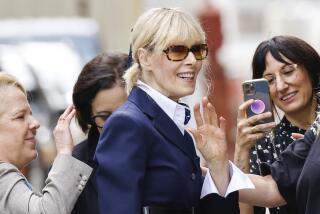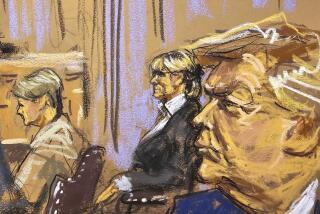Literary Sessions Suited for the Curiouser
The outrageous tea party in “Alice’s Adventures in Wonderland” pours lessons for modern medicine -- and life.
Pediatrician George Cassady discovered that decades ago when he read the Lewis Carroll classic to his children. The insight led in an unforeseen way to a current exhibition at USC and an academic conference starting today about the beloved but also much debated 19th century author, photographer and mathematician.
At the tea party, the Mad Hatter complains that his watch remains broken and that the March Hare should not have used butter in trying to fix it. To which the March Hare meekly replies: “It was the best butter.”
The Hare’s approach reminded Cassady, he recalled this week, of doctors who rush to medical fads “without a careful comparison to less costly, better established treatments.”
Cassady began citing the butter anecdote and other Alice quotes in cautionary lectures to his medical school students and he soon started to passionately collect rare “Wonderland” editions, Carroll biographies, Alice-themed magnets and Christmas ornaments.
The results of Cassady’s fascination are now on display at USC’s Doheny Memorial Library -- about 80 of the 1,000 Carroll items he has donated to his alma mater, along with a $100,000 endowment for conferences and other purchases. Cassady, 71, will be a guest of honor at the symposium, “Lewis Carroll and the Idea of Childhood,” being held at Doheny today and at the Huntington Library, Art Collections and Botanical Gardens in San Marino on Saturday.
The conference will examine the life and work of Charles Lutwidge Dodgson (1832-1898), the British math professor who wrote under the Carroll nom de plume and is best known for his two wildly imaginative Alice books.
Since their first editions with drawings by John Tenniel, “Wonderland” and its sequel, “Through the Looking-Glass and What Alice Found There,” have inspired many writers, artists, filmmakers, classical musicians and acid rockers.
Alice’s encounters with the White Rabbit, the Red Queen, the Cheshire Cat, Tweedledee and Tweedledum entertain youngsters with their wordplay but also prod adults to consider absurdities in their own lives, Cassady said.
In addition, he said the books helped him be more “straightforward and honest” with his patients and his children. “Alice looks at things very literally and sees a lack of logic in what the grown-ups are doing,” Cassady, who has taught at Stanford and Harvard, said in an interview from his Northern California home.
USC English professor James R. Kincaid, who helped organize the conference, attributes the staying power of Carroll’s books to the unusual way they engage children and adults. Academics can debate the philosophical, political, linguistic and mathematical content “in ways that don’t disrupt the enjoyment of kids,” he said.
But scholars also have debated Carroll’s fascination with children, his close friendships with young girls and his photography of them, including a few nude shots.
To some modern eyes, those photos can have an upsettingly erotic flavor. Today, a photographer who asked a parent’s permission to take nude photos of a girl “would end up in the slammer pretty fast,” Kincaid said. But Carroll actually was trying to portray the Victorians’ ideals of childhood as a time of exalted innocence and closeness to God, he said. Other scholars describe Carroll as a likely repressed pedophile who never molested a child.
The conference keynote speaker is Stanford English professor Robert Polhemus, whose lecture “Lewis Carroll and the Idolatry of the Child” compares the author’s fascination to religious experiences.
Other speakers include Diane Waggoner, a photography specialist from the National Gallery of Art, who is to discuss Carroll’s lesser-known photos of boys, and British expert Selwyn Goodacre, who is to analyze such issues as “a child alone amongst strange adults in an alien world,” according to advance summaries.
Carroll’s enigmatic personality makes him a magnet for scholars, said Tyson Gaskill, USC libraries’ director of programming. “Once you think you know him, he kind of slips out from beneath your thumb,” Gaskill said.
The all-day sessions, sponsored by USC and the Huntington, start both days at 10:30 a.m. and are free to the public. More than 100 scholars and Carroll fans are expected to attend.
The free exhibit “The Curious World of Lewis Carroll” will continue at Doheny library through May 24.
The Cassady collection includes first and early editions of Carroll’s “Wonderland” books. The display also includes Victorian playing cards, musical scores, a Mad Hatter doll and snippets from Alice movies.
Conference participants will be able to see a very recent Cassady acquisition that came to the USC library too late to be mounted in the exhibit: a “Wonderland” copy signed by Alice Liddell, the real Alice who, as a child many years earlier, urged Carroll to write down the wonderful tales with which he had regaled her and her sisters.
More to Read
Sign up for our Book Club newsletter
Get the latest news, events and more from the Los Angeles Times Book Club, and help us get L.A. reading and talking.
You may occasionally receive promotional content from the Los Angeles Times.







